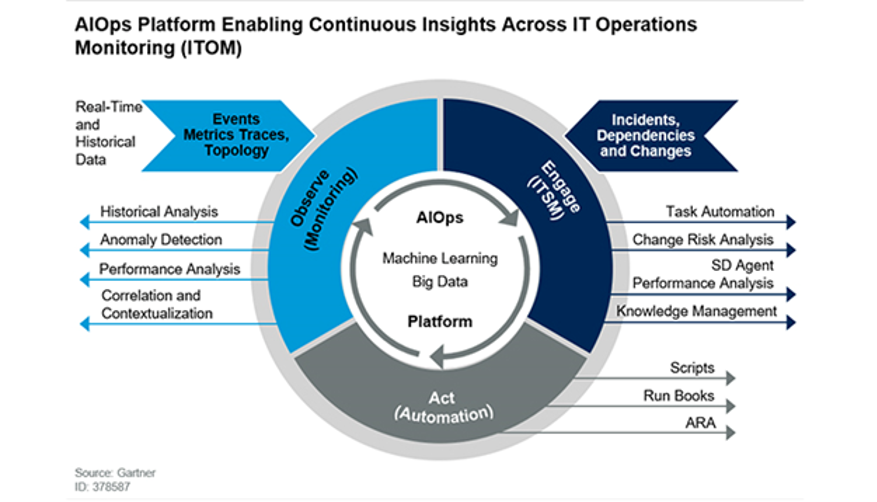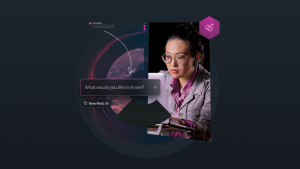Note: A version of this post originally ran on The New Stack on 11/18/2020.
A few years ago, Gartner predicted a significant shake-up to ITOps procedures. They coined the term “AIOps.” It is an evolving solution that would revolutionize how IT ecosystems are managed.
Advances in the IT world since have proven Gartner’s prediction to be right on the money. Interest in and the adoption of AIOps is growing. Organizations are using the new technology to improve uptime, reduce toil, and manage the ever-increasing volume and velocity of digital data.
Let’s take a closer look at AIOps and examine how you can get started.
What is AIOps?
AIOps is the application of data science and machine learning (ML) to IT operations. AIOps solutions combine the power of big data with ML functionality to improve primary IT operations functions, such as performance monitoring, analysis, and IT service management.

AIOps solutions gather and examine the volume of data generated by a business’s IT network. Then they present that information in a useful, easy-to-understand way. Gartner predicts that large enterprise use of AIOps tools to oversee infrastructure and applications will jump from 5% in 2018 to 30% in 2023.
Driving forces behind AIOps
AIOps represents the next stage in the evolution of IT operational analytics. Propelling the transformation are several trends, including:
- The exponential increases in data ITOps need to retain. Performance monitoring platforms are grappling with an exponentially larger quantity of data than ever before. Growing numbers of IoT devices, APIs, applications, and digital and machine users mean organizing and analyzing data has become too complex for manual processes.
- IT environments are becoming too huge for humans to handle. Old-school methods of managing IT require human intervention and manual efforts. This simply will not cut it anymore. When human oversight is no longer possible, AI and ML assistance come into play.
- Infrastructure and network problems must be remedied at lightning speeds. As more and more organizations digitize their business, IT becomes a foundational, business-critical component. Consumers expect optimized performance and the bar is continually being raised. This means companies must address IT issues as quickly as possible–ideally before the end user even knows there is a problem.
Before you get started with AIOps, it is worth noting that machines are not replacing humans. Yes, ITOps management is exceeding human capacity. And yes, companies will require AI, ML, big data, and automation to cope with the never-ending wave of incoming data. But personnel will be critical to these processes–albeit personnel with a new set of skills in a new range of roles.
Getting started with AIOps
Ready to take advantage of AIOps in your business? You will no doubt face a bit of a learning curve, and it will take some trial and error before you unlock and unleash the full potential of this IT innovation. But trust the process. In the end, it not only will be worth it, but could also be critical to your business’s success.
To help you get the most out of AIOps, here are our top tips for getting started.
Tip 1: Act Fast
Even if an AIOps project isn’t imminent in your organization, become familiar with AI and ML capabilities today. Priorities can change at the blink of an eye, and AIOps knowledge may soon become a top priority.
Tip 2: Select Initial Test Cases Carefully
When it comes to something as transformative as AIOps, start small. Choose a low-scale test case, learn, adapt, tweak, and grow from there. That way, if things go wrong, the consequences won’t be quite so disastrous.
Tip 3: Showcase Your Proficiency
People can be resistant to change. It is your job to demystify AIOps for leadership and your colleagues by showcasing your proficiency, demonstrating fundamental techniques, and ensuring the potential benefits are understood. Identify experience and skill gaps and create actionable plans to fill those gaps.
Tip 4: Experiment
Leading AIOps platforms offer customizability. Jump in and experiment with features and configurations. See what you can do to make AIOps as valuable as possible for your organization.
AIOps in action
What kinds of problems could AIOps address in real-life situations? Let’s take a look at an incident that took place just a few years ago.
Two of Australia’s largest supermarket chains experienced extreme technical issues. So extreme, in fact, they were forced to close several of their stores while they worked on fixing up the problem.
During the shutdown, these companies lost revenue. They also took a pretty serious hit to their reputation. Customers were not happy. And who could blame them?
These are the types of disastrous outages that could be identified, addressed, and fixed faster with AIOps. Many could be avoided altogether.
The future of AIOps
We’ve answered, “What is AIOps?” We’ve examined the driving trends that have led us to the current market. We’ve also shared our tips for getting started. Now, let’s look forward.
As IT continues to push past human limits, there is no doubt that tools will have to adapt and expand. Reacting, however, will not be enough. Organizations must see the challenge as an opportunity to innovate, grow, expand, experiment, and disrupt.
Of course, the future of technology is unknown, and we can only make educated guesses. Trends are pointing to a world with more artificial intelligence and more machine learning, both of which are applied in AIOps. It's safe to say that businesses that shy away from these new, disruptive technologies will pay the price. Now is the time to take action and secure your competitive edge.
If you’re ready for a deeper dive, don’t miss our ebook, How to Prepare for AIOps: Four steps for a successful deployment.
As opiniões expressas neste blog são de responsabilidade do autor e não refletem necessariamente as opiniões da New Relic. Todas as soluções oferecidas pelo autor são específicas do ambiente e não fazem parte das soluções comerciais ou do suporte oferecido pela New Relic. Junte-se a nós exclusivamente no Explorers Hub ( discuss.newrelic.com ) para perguntas e suporte relacionados a esta postagem do blog. Este blog pode conter links para conteúdo de sites de terceiros. Ao fornecer esses links, a New Relic não adota, garante, aprova ou endossa as informações, visualizações ou produtos disponíveis em tais sites.



